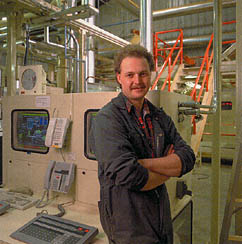 |
Imperial Tobacco's leaf processing operations in Aylmer, Ontario have been upgraded to meet the highest possible standards and ensure efficient operations. |
Imasco Limited, with headquarters in Montreal, is one of Canada’s largest corporations. It was formed in 1970 to diversify Imperial Tobacco Company into other consumer markets.
Hallmarks of Imasco’s growth have been investing in outstanding organizations and furthering the dreams of entrepreneurs. Each Imasco company is an important thread of success woven into the corporate tapestry. Imperial Tobacco, Shoppers Drug Mart, and Canada Trust are such success stories. Each illustrates Imasco’s driving spirit: responding to consumer needs with the highest quality goods and services while helping to build strong communities.
Imperial Tobacco Company: The Origins of Imasco
Imperial Tobacco Company was incorporated in 1912 when the Canadian tobacco industry was still in its infancy. It began as a consolidation of two Montreal companies and over its eighty-year history has acquired many other tobacco businesses.
During World War
II, Imperial embarked on a goodwill program of distributing its cigarettes
to Canadian troops abroad, which also served to keep brand loyalty alive.
The war stimulated Canadian economic growth and, during the post-war boom,
Imperial constructed additional plants in Ontario and Quebec. Its engineers
began experimenting with machinery for processing leaf tobacco which was
subsequently licensed to manufacturers around the world.
 |
Imperial Tobacco's leaf processing operations in Aylmer, Ontario have been upgraded to meet the highest possible standards and ensure efficient operations. |
In the early seventies, TV and radio advertising of tobacco products were discontinued, and Imperial decided to channel some of its advertising and promotion budget into support for professional sports events and the arts. This support grew over the years and continues to this day.
By 1980, Imperial’s Player’s brand had become Canada’s most popular cigarette and the company was the country’s undisputed industry leader.
Today, Imperial Tobacco continues to flourish, led by the two largest selling domestic cigarette brand families, Player’s and du Maurier. The company employs over 2,700 people in all phases of the industry, from the purchase of raw tobacco leaf to the distribution of final products.
Shoppers Drug Mart: Joining forces with a Force
When scarcely 20 years old, Murray Koffler inherited two neighbourhood drug stores in Toronto. He went to pharmacy school, learned the heart of the business, then proceeded to redefine it. The end result was Shoppers Drug Mart.
With typical bold
strokes, Koffler revamped the concept of the twentieth century “drug store”
in Canada by ripping out the soda fountain and emphasising the dispensary,
requiring his pharmacists to wear starched white coats as a symbol of their
professionalism. To that he added consumer-oriented approaches in merchandising
and promotion. In the mid-’50s, he began acquiring other drug stores and
organized them around a then-novel franchising concept: pharmacist “associates”
would own and operate their own stores within the system and share in the
profits. The concept turned out to be a cornerstone of the chain’s success.
 |
A former bank branch, the two-storey Shoppers Drug Mart at the intersection of Yonge and King, in downtown Toronto, is unique and very spacious for a drug store in the city centre. |
In 1962, Koffler’s 17-store chain became known as Shoppers Drug Mart. It went public, and major expansion occurred through acquisition and mergers in the ‘60s and in the ‘70s. Upon entering the chain, stores typically doubled their previous year’s profits.
When it was time to sell his business, Murray Koffler chose Imasco largely because of its strong financial position but also because he liked Imasco’s tradition of sponsoring worthy Canadian causes. A philanthropist in his own right, Koffler had seen to it that Shoppers had an established reputation as a leading educator on health issues as well as a supporter of hospital fundraising.
Shoppers Drug Mart continues to grow and develop under Imasco’s ownership. In today’s Shoppers, pharmacists serve as health advisors and are important liaisons between physician and patient. It’s a far cry from soda fountain days!
Canada Trust: Helping to build a Community
In 1986, Imasco acquired Canada Trust, one of the largest financial institutions in Canada. The company had its origins in the frontier days of Canada as the Huron & Erie Savings and Loan Society (H&E), a “building society” established in 1864 in London, Ontario, then the country’s western edge. Formed by 25 London businessmen, the H&E was instrumental in shaping a stable and prosperous community.
Through building societies, people would pool their savings to finance the purchase of land by others. Innovative rules allowed borrowers to pay back their debts in monthly instalments of principal plus interest. The concept was ideally suited to the development of pre-confederation Canada. Capital was scarce in those days, for banks handled only commercial accounts, and people literally stashed their savings under mattresses.
Loans which enabled
farmers to buy their land were H&E’s dominant business for many years,
and stories abound about the travelling valuators who had to conquer near
impassable terrain on horseback to make their reports. In 1898, H&E
acquired General Trust Corporation of Calgary which led to the formation
in 1901 of an H&E subsidiary named Canada Trust.
 |
With busier lifestyles and demographic changes, customers require more flexible and accessible financial services. Canada Trust's EasyLine is one of the most innovative telephon banking services available anywhere. |
The depression brought on difficult times, made more so in the prairies by drought and the subsequent abandonment of land and loans. The company supported its beleaguered customers, advancing money for seed, sometimes accepting harvested crops as payments on mortgages. Not surprisingly, profits dwindled and did not regain their 1930 level until 1950.
The outbreak of World War II began an economic recovery and, by 1946, it was clear that if the company was going to grow, it would have to acquire other trust companies with good business volumes. This it did, and it also entered the field of corporate pension fund administration. By 1957, the company’s two names began to meld into one corporate image, Canada Trust.
Over the course of the ‘60s and ‘70s, Canada Trust emphasized personal financial services and developed its well-earned reputation for friendliness and convenience. And through its active residential mortgage program, the company is staying true to its early mission of helping Canadians invest in their own communities.